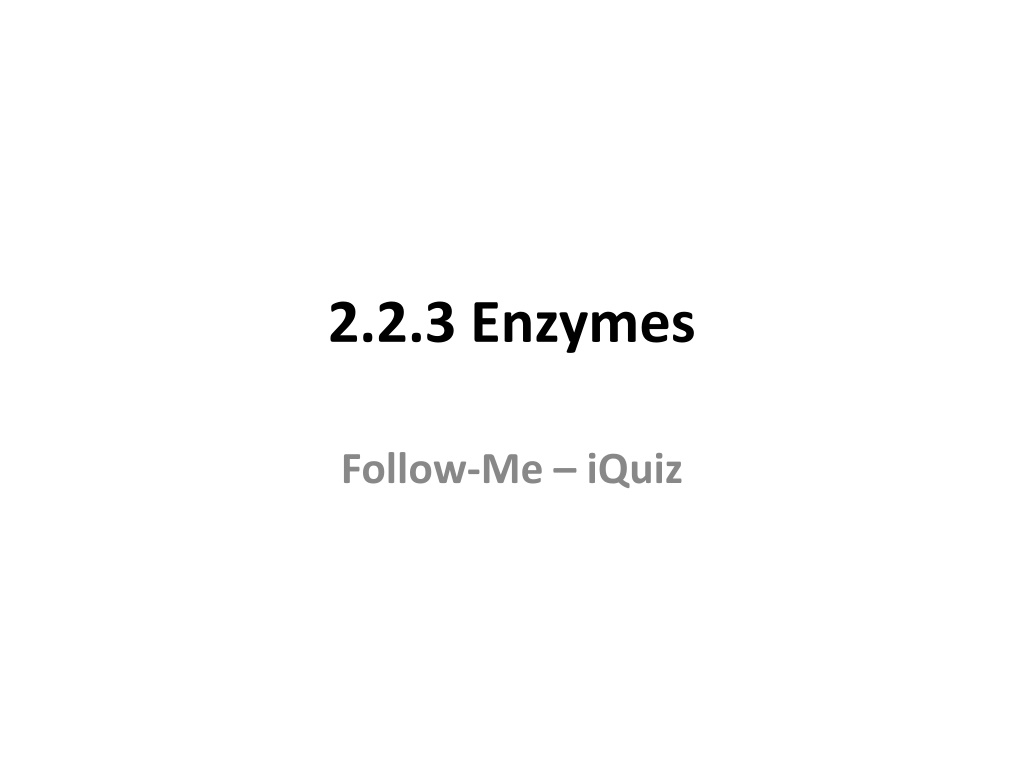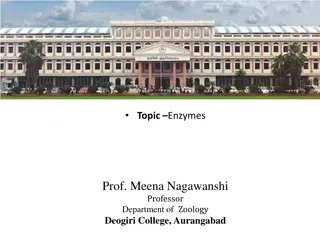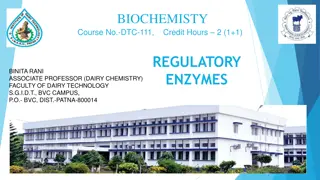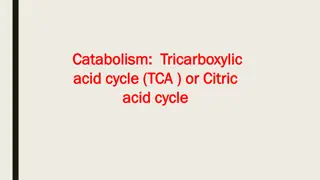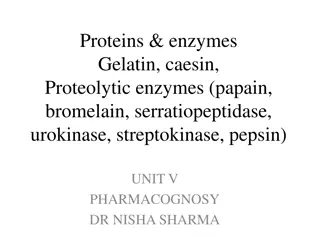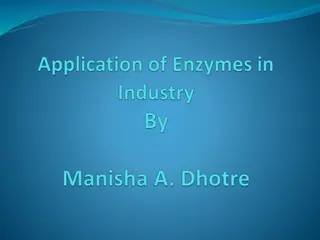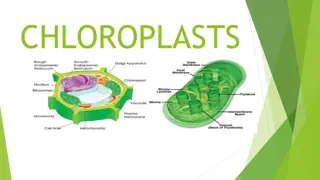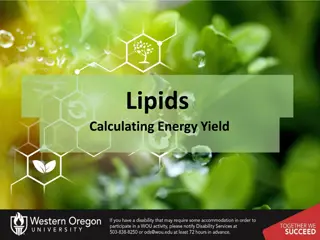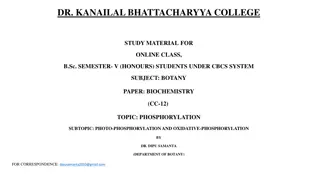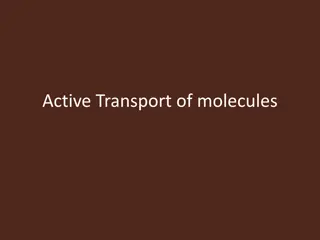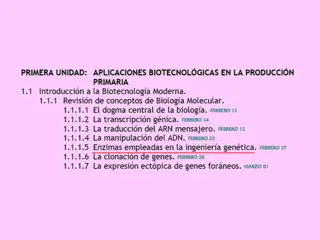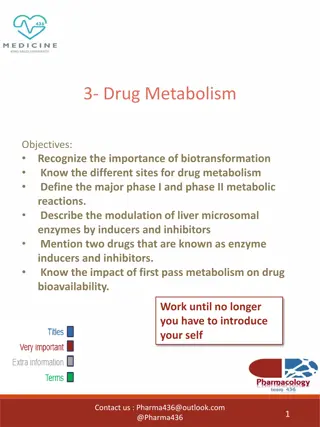Understanding Metabolism: Enzymes and ATP
Explore the concept of metabolism through the roles of enzymes and ATP. Learn about chemical reactions in living cells, substrate interactions, and the essential functions of Adenosine Triphosphate. Test your knowledge with interactive quizzes and uncover the key principles governing cellular processes.
Download Presentation

Please find below an Image/Link to download the presentation.
The content on the website is provided AS IS for your information and personal use only. It may not be sold, licensed, or shared on other websites without obtaining consent from the author. Download presentation by click this link. If you encounter any issues during the download, it is possible that the publisher has removed the file from their server.
E N D
Presentation Transcript
2.2.3 Enzymes Follow-Me iQuiz
Q. What is meant by the term metabolism? Fits substrate; Active site; Folded; Can change shape Adenosine Triphosphate Substrate Fits substrate; Active site; Folded; Can change shape Adenosine Triphosphate Substrate All chemical reactions in living cells Keep pH constant Temperature; pH All chemical reactions in living cells Keep pH constant Temperature; pH Breakdown of large molecules into smaller ones TRUE May damage skin Breakdown of large molecules into smaller ones TRUE May damage skin By the volume of suds produced Used buffers Nitrogen By the volume of suds produced Used buffers Nitrogen Catalyst and chemical messenger Organic protein catalyst Using micro-organisms or enzymes to make product(s) Catalyst and chemical messenger Using micro-organisms or enzymes to make product(s) Organic protein catalyst Enzyme can be recovered Product Vessel in which products are made by cells or organisms. Enzyme can be recovered Vessel in which products are made by cells or organisms. Product Enzyme trapped in beads or gel so that it will react with, but not mix with, its substrate Enzyme trapped in beads or gel so that it will react with, but not mix with, its substrate Water bath; Ice; Thermostat Proteins Water bath; Ice; Thermostat Proteins Working at maximum rate Sodium alginate FALSE Working at maximum rate Sodium alginate FALSE
CONGRATULATIONS Please CLICK on THIS BOX for the Next Question Please CLICK on THIS BOX for the Next Question
Q. For what is ATP an abbreviation? Fits substrate; Active site; Folded; Can change shape Adenosine Triphosphate Substrate Fits substrate; Active site; Folded; Can change shape Adenosine Triphosphate Substrate All chemical reactions in living cells Keep pH constant Temperature; pH All chemical reactions in living cells Keep pH constant Temperature; pH Breakdown of large molecules into smaller ones TRUE May damage skin Breakdown of large molecules into smaller ones TRUE May damage skin By the volume of suds produced Used buffers Nitrogen By the volume of suds produced Used buffers Nitrogen Catalyst and chemical messenger Organic protein catalyst Using micro-organisms or enzymes to make product(s) Catalyst and chemical messenger Using micro-organisms or enzymes to make product(s) Organic protein catalyst Enzyme can be recovered Product Vessel in which products are made by cells or organisms. Enzyme can be recovered Vessel in which products are made by cells or organisms. Product Enzyme trapped in beads or gel so that it will react with, but not mix with, its substrate Enzyme trapped in beads or gel so that it will react with, but not mix with, its substrate Water bath; Ice; Thermostat Proteins Water bath; Ice; Thermostat Proteins Working at maximum rate Sodium alginate FALSE Working at maximum rate Sodium alginate FALSE
CONGRATULATIONS Please CLICK on THIS BOX for the Next Question Please CLICK on THIS BOX for the Next Question
Q. To which group of molecules do enzymes belong? Fits substrate; Active site; Folded; Can change shape Adenosine Triphosphate Substrate Fits substrate; Active site; Folded; Can change shape Adenosine Triphosphate Substrate All chemical reactions in living cells Keep pH constant Temperature; pH All chemical reactions in living cells Keep pH constant Temperature; pH Breakdown of large molecules into smaller ones TRUE May damage skin Breakdown of large molecules into smaller ones TRUE May damage skin By the volume of suds produced Used buffers Nitrogen By the volume of suds produced Used buffers Nitrogen Catalyst and chemical messenger Organic protein catalyst Using micro-organisms or enzymes to make product(s) Catalyst and chemical messenger Using micro-organisms or enzymes to make product(s) Organic protein catalyst Enzyme can be recovered Product Vessel in which products are made by cells or organisms. Enzyme can be recovered Vessel in which products are made by cells or organisms. Product Enzyme trapped in beads or gel so that it will react with, but not mix with, its substrate Enzyme trapped in beads or gel so that it will react with, but not mix with, its substrate Water bath; Ice; Thermostat Proteins Water bath; Ice; Thermostat Proteins Working at maximum rate Sodium alginate FALSE Working at maximum rate Sodium alginate FALSE
CONGRATULATIONS Please CLICK on THIS BOX for the Next Question Please CLICK on THIS BOX for the Next Question
Q. In an experiment that you carried out to investigate the effect of pH on the rate of enzyme action, explain how you varied the pH. Fits substrate; Active site; Folded; Can change shape Adenosine Triphosphate Substrate Fits substrate; Active site; Folded; Can change shape Adenosine Triphosphate Substrate All chemical reactions in living cells Keep pH constant Temperature; pH All chemical reactions in living cells Keep pH constant Temperature; pH Breakdown of large molecules into smaller ones TRUE May damage skin Breakdown of large molecules into smaller ones TRUE May damage skin By the volume of suds produced Used buffers Nitrogen By the volume of suds produced Used buffers Nitrogen Catalyst and chemical messenger Organic protein catalyst Using micro-organisms or enzymes to make product(s) Catalyst and chemical messenger Using micro-organisms or enzymes to make product(s) Organic protein catalyst Enzyme can be recovered Product Vessel in which products are made by cells or organisms. Enzyme can be recovered Vessel in which products are made by cells or organisms. Product Enzyme trapped in beads or gel so that it will react with, but not mix with, its substrate Enzyme trapped in beads or gel so that it will react with, but not mix with, its substrate Water bath; Ice; Thermostat Proteins Water bath; Ice; Thermostat Proteins Working at maximum rate Sodium alginate FALSE Working at maximum rate Sodium alginate FALSE
CONGRATULATIONS Please CLICK on THIS BOX for the Next Question Please CLICK on THIS BOX for the Next Question
Q. What is a bioreactor? Fits substrate; Active site; Folded; Can change shape Adenosine Triphosphate Substrate Fits substrate; Active site; Folded; Can change shape Adenosine Triphosphate Substrate All chemical reactions in living cells Keep pH constant Temperature; pH All chemical reactions in living cells Keep pH constant Temperature; pH Breakdown of large molecules into smaller ones TRUE May damage skin Breakdown of large molecules into smaller ones TRUE May damage skin By the volume of suds produced Used buffers Nitrogen By the volume of suds produced Used buffers Nitrogen Catalyst and chemical messenger Organic protein catalyst Using micro-organisms or enzymes to make product(s) Catalyst and chemical messenger Using micro-organisms or enzymes to make product(s) Organic protein catalyst Enzyme can be recovered Product Vessel in which products are made by cells or organisms. Enzyme can be recovered Vessel in which products are made by cells or organisms. Product Enzyme trapped in beads or gel so that it will react with, but not mix with, its substrate Enzyme trapped in beads or gel so that it will react with, but not mix with, its substrate Water bath; Ice; Thermostat Proteins Water bath; Ice; Thermostat Proteins Working at maximum rate Sodium alginate FALSE Working at maximum rate Sodium alginate FALSE
CONGRATULATIONS Please CLICK on THIS BOX for the Next Question Please CLICK on THIS BOX for the Next Question
Q. What is meant by an enzyme? Fits substrate; Active site; Folded; Can change shape Adenosine Triphosphate Substrate Fits substrate; Active site; Folded; Can change shape Adenosine Triphosphate Substrate All chemical reactions in living cells Keep pH constant Temperature; pH All chemical reactions in living cells Keep pH constant Temperature; pH Breakdown of large molecules into smaller ones TRUE May damage skin Breakdown of large molecules into smaller ones TRUE May damage skin By the volume of suds produced Used buffers Nitrogen By the volume of suds produced Used buffers Nitrogen Catalyst and chemical messenger Organic protein catalyst Using micro-organisms or enzymes to make product(s) Catalyst and chemical messenger Using micro-organisms or enzymes to make product(s) Organic protein catalyst Enzyme can be recovered Product Vessel in which products are made by cells or organisms. Enzyme can be recovered Vessel in which products are made by cells or organisms. Product Enzyme trapped in beads or gel so that it will react with, but not mix with, its substrate Enzyme trapped in beads or gel so that it will react with, but not mix with, its substrate Water bath; Ice; Thermostat Proteins Water bath; Ice; Thermostat Proteins Working at maximum rate Sodium alginate FALSE Working at maximum rate Sodium alginate FALSE
CONGRATULATIONS Please CLICK on THIS BOX for the Next Question Please CLICK on THIS BOX for the Next Question
Q. What is meant by immobilisation? Fits substrate; Active site; Folded; Can change shape Adenosine Triphosphate Substrate Fits substrate; Active site; Folded; Can change shape Adenosine Triphosphate Substrate All chemical reactions in living cells Keep pH constant Temperature; pH All chemical reactions in living cells Keep pH constant Temperature; pH Breakdown of large molecules into smaller ones TRUE May damage skin Breakdown of large molecules into smaller ones TRUE May damage skin By the volume of suds produced Used buffers Nitrogen By the volume of suds produced Used buffers Nitrogen Catalyst and chemical messenger Organic protein catalyst Using micro-organisms or enzymes to make product(s) Catalyst and chemical messenger Using micro-organisms or enzymes to make product(s) Organic protein catalyst Enzyme can be recovered Product Vessel in which products are made by cells or organisms. Enzyme can be recovered Vessel in which products are made by cells or organisms. Product Enzyme trapped in beads or gel so that it will react with, but not mix with, its substrate Enzyme trapped in beads or gel so that it will react with, but not mix with, its substrate Water bath; Ice; Thermostat Proteins Water bath; Ice; Thermostat Proteins Working at maximum rate Sodium alginate FALSE Working at maximum rate Sodium alginate FALSE
CONGRATULATIONS Please CLICK on THIS BOX for the Next Question Please CLICK on THIS BOX for the Next Question
Q. Name a factor that influences the activity of an enzyme. Fits substrate; Active site; Folded; Can change shape Adenosine Triphosphate Substrate Fits substrate; Active site; Folded; Can change shape Adenosine Triphosphate Substrate All chemical reactions in living cells Keep pH constant Temperature; pH All chemical reactions in living cells Keep pH constant Temperature; pH Breakdown of large molecules into smaller ones TRUE May damage skin Breakdown of large molecules into smaller ones TRUE May damage skin By the volume of suds produced Used buffers Nitrogen By the volume of suds produced Used buffers Nitrogen Catalyst and chemical messenger Organic protein catalyst Using micro-organisms or enzymes to make product(s) Catalyst and chemical messenger Using micro-organisms or enzymes to make product(s) Organic protein catalyst Enzyme can be recovered Product Vessel in which products are made by cells or organisms. Enzyme can be recovered Vessel in which products are made by cells or organisms. Product Enzyme trapped in beads or gel so that it will react with, but not mix with, its substrate Enzyme trapped in beads or gel so that it will react with, but not mix with, its substrate Water bath; Ice; Thermostat Proteins Water bath; Ice; Thermostat Proteins Working at maximum rate Sodium alginate FALSE Working at maximum rate Sodium alginate FALSE
CONGRATULATIONS Please CLICK on THIS BOX for the Next Question Please CLICK on THIS BOX for the Next Question
Q. State one advantage of using an immobilised enzyme in a bioreactor. Fits substrate; Active site; Folded; Can change shape Adenosine Triphosphate Substrate Fits substrate; Active site; Folded; Can change shape Adenosine Triphosphate Substrate All chemical reactions in living cells Keep pH constant Temperature; pH All chemical reactions in living cells Keep pH constant Temperature; pH Breakdown of large molecules into smaller ones TRUE May damage skin Breakdown of large molecules into smaller ones TRUE May damage skin By the volume of suds produced Used buffers Nitrogen By the volume of suds produced Used buffers Nitrogen Catalyst and chemical messenger Organic protein catalyst Using micro-organisms or enzymes to make product(s) Catalyst and chemical messenger Using micro-organisms or enzymes to make product(s) Organic protein catalyst Enzyme can be recovered Product Vessel in which products are made by cells or organisms. Enzyme can be recovered Vessel in which products are made by cells or organisms. Product Enzyme trapped in beads or gel so that it will react with, but not mix with, its substrate Enzyme trapped in beads or gel so that it will react with, but not mix with, its substrate Water bath; Ice; Thermostat Proteins Water bath; Ice; Thermostat Proteins Working at maximum rate Sodium alginate FALSE Working at maximum rate Sodium alginate FALSE
CONGRATULATIONS Please CLICK on THIS BOX for the Next Question Please CLICK on THIS BOX for the Next Question
Q. Name a substance that is used to immobilise enzymes. Fits substrate; Active site; Folded; Can change shape Adenosine Triphosphate Substrate Fits substrate; Active site; Folded; Can change shape Adenosine Triphosphate Substrate All chemical reactions in living cells Keep pH constant Temperature; pH All chemical reactions in living cells Keep pH constant Temperature; pH Breakdown of large molecules into smaller ones TRUE May damage skin Breakdown of large molecules into smaller ones TRUE May damage skin By the volume of suds produced Used buffers Nitrogen By the volume of suds produced Used buffers Nitrogen Catalyst and chemical messenger Organic protein catalyst Using micro-organisms or enzymes to make product(s) Catalyst and chemical messenger Using micro-organisms or enzymes to make product(s) Organic protein catalyst Enzyme can be recovered Product Vessel in which products are made by cells or organisms. Enzyme can be recovered Vessel in which products are made by cells or organisms. Product Enzyme trapped in beads or gel so that it will react with, but not mix with, its substrate Enzyme trapped in beads or gel so that it will react with, but not mix with, its substrate Water bath; Ice; Thermostat Proteins Water bath; Ice; Thermostat Proteins Working at maximum rate Sodium alginate FALSE Working at maximum rate Sodium alginate FALSE
CONGRATULATIONS Please CLICK on THIS BOX for the Next Question Please CLICK on THIS BOX for the Next Question
Q. State a use for Buffer solution in the biology laboratory. Fits substrate; Active site; Folded; Can change shape Adenosine Triphosphate Substrate Fits substrate; Active site; Folded; Can change shape Adenosine Triphosphate Substrate All chemical reactions in living cells Keep pH constant Temperature; pH All chemical reactions in living cells Keep pH constant Temperature; pH Breakdown of large molecules into smaller ones TRUE May damage skin Breakdown of large molecules into smaller ones TRUE May damage skin By the volume of suds produced Used buffers Nitrogen By the volume of suds produced Used buffers Nitrogen Catalyst and chemical messenger Organic protein catalyst Using micro-organisms or enzymes to make product(s) Catalyst and chemical messenger Using micro-organisms or enzymes to make product(s) Organic protein catalyst Enzyme can be recovered Product Vessel in which products are made by cells or organisms. Enzyme can be recovered Vessel in which products are made by cells or organisms. Product Enzyme trapped in beads or gel so that it will react with, but not mix with, its substrate Enzyme trapped in beads or gel so that it will react with, but not mix with, its substrate Water bath; Ice; Thermostat Proteins Water bath; Ice; Thermostat Proteins Working at maximum rate Sodium alginate FALSE Working at maximum rate Sodium alginate FALSE
CONGRATULATIONS Please CLICK on THIS BOX for the Next Question Please CLICK on THIS BOX for the Next Question
Q. Apart from C, H and O, there is one other element always present in the building blocks of enzymes. Name that element. Fits substrate; Active site; Folded; Can change shape Adenosine Triphosphate Substrate Fits substrate; Active site; Folded; Can change shape Adenosine Triphosphate Substrate All chemical reactions in living cells Keep pH constant Temperature; pH All chemical reactions in living cells Keep pH constant Temperature; pH Breakdown of large molecules into smaller ones TRUE May damage skin Breakdown of large molecules into smaller ones TRUE May damage skin By the volume of suds produced Used buffers Nitrogen By the volume of suds produced Used buffers Nitrogen Catalyst and chemical messenger Organic protein catalyst Using micro-organisms or enzymes to make product(s) Catalyst and chemical messenger Using micro-organisms or enzymes to make product(s) Organic protein catalyst Enzyme can be recovered Product Vessel in which products are made by cells or organisms. Enzyme can be recovered Vessel in which products are made by cells or organisms. Product Enzyme trapped in beads or gel so that it will react with, but not mix with, its substrate Enzyme trapped in beads or gel so that it will react with, but not mix with, its substrate Water bath; Ice; Thermostat Proteins Water bath; Ice; Thermostat Proteins Working at maximum rate Sodium alginate FALSE Working at maximum rate Sodium alginate FALSE
CONGRATULATIONS Please CLICK on THIS BOX for the Next Question Please CLICK on THIS BOX for the Next Question
Q. Distinguish between Enzymes and Hormones Fits substrate; Active site; Folded; Can change shape Adenosine Triphosphate Substrate Fits substrate; Active site; Folded; Can change shape Adenosine Triphosphate Substrate All chemical reactions in living cells Keep pH constant Temperature; pH All chemical reactions in living cells Keep pH constant Temperature; pH Breakdown of large molecules into smaller ones TRUE May damage skin Breakdown of large molecules into smaller ones TRUE May damage skin By the volume of suds produced Used buffers Nitrogen By the volume of suds produced Used buffers Nitrogen Catalyst and chemical messenger Organic protein catalyst Using micro-organisms or enzymes to make product(s) Catalyst and chemical messenger Using micro-organisms or enzymes to make product(s) Organic protein catalyst Enzyme can be recovered Product Vessel in which products are made by cells or organisms. Enzyme can be recovered Vessel in which products are made by cells or organisms. Product Enzyme trapped in beads or gel so that it will react with, but not mix with, its substrate Enzyme trapped in beads or gel so that it will react with, but not mix with, its substrate Water bath; Ice; Thermostat Proteins Water bath; Ice; Thermostat Proteins Working at maximum rate Sodium alginate FALSE Working at maximum rate Sodium alginate FALSE
CONGRATULATIONS Please CLICK on THIS BOX for the Next Question Please CLICK on THIS BOX for the Next Question
Q. Give the term for the substance that results from the action of an enzyme on its substrate. Fits substrate; Active site; Folded; Can change shape Adenosine Triphosphate Substrate Fits substrate; Active site; Folded; Can change shape Adenosine Triphosphate Substrate All chemical reactions in living cells Keep pH constant Temperature; pH All chemical reactions in living cells Keep pH constant Temperature; pH Breakdown of large molecules into smaller ones TRUE May damage skin Breakdown of large molecules into smaller ones TRUE May damage skin By the volume of suds produced Used buffers Nitrogen By the volume of suds produced Used buffers Nitrogen Catalyst and chemical messenger Organic protein catalyst Using micro-organisms or enzymes to make product(s) Catalyst and chemical messenger Using micro-organisms or enzymes to make product(s) Organic protein catalyst Enzyme can be recovered Product Vessel in which products are made by cells or organisms. Enzyme can be recovered Vessel in which products are made by cells or organisms. Product Enzyme trapped in beads or gel so that it will react with, but not mix with, its substrate Enzyme trapped in beads or gel so that it will react with, but not mix with, its substrate Water bath; Ice; Thermostat Proteins Water bath; Ice; Thermostat Proteins Working at maximum rate Sodium alginate FALSE Working at maximum rate Sodium alginate FALSE
CONGRATULATIONS Please CLICK on THIS BOX for the Next Question Please CLICK on THIS BOX for the Next Question
Q. In relation to an enzyme, explain the term optimum activity. Fits substrate; Active site; Folded; Can change shape Adenosine Triphosphate Substrate Fits substrate; Active site; Folded; Can change shape Adenosine Triphosphate Substrate All chemical reactions in living cells Keep pH constant Temperature; pH All chemical reactions in living cells Keep pH constant Temperature; pH Breakdown of large molecules into smaller ones TRUE May damage skin Breakdown of large molecules into smaller ones TRUE May damage skin By the volume of suds produced Used buffers Nitrogen By the volume of suds produced Used buffers Nitrogen Catalyst and chemical messenger Organic protein catalyst Using micro-organisms or enzymes to make product(s) Catalyst and chemical messenger Using micro-organisms or enzymes to make product(s) Organic protein catalyst Enzyme can be recovered Product Vessel in which products are made by cells or organisms. Enzyme can be recovered Vessel in which products are made by cells or organisms. Product Enzyme trapped in beads or gel so that it will react with, but not mix with, its substrate Enzyme trapped in beads or gel so that it will react with, but not mix with, its substrate Water bath; Ice; Thermostat Proteins Water bath; Ice; Thermostat Proteins Working at maximum rate Sodium alginate FALSE Working at maximum rate Sodium alginate FALSE
CONGRATULATIONS Please CLICK on THIS BOX for the Next Question Please CLICK on THIS BOX for the Next Question
Q. Explain the term bioprocessing. Fits substrate; Active site; Folded; Can change shape Adenosine Triphosphate Substrate Fits substrate; Active site; Folded; Can change shape Adenosine Triphosphate Substrate All chemical reactions in living cells Keep pH constant Temperature; pH All chemical reactions in living cells Keep pH constant Temperature; pH Breakdown of large molecules into smaller ones TRUE May damage skin Breakdown of large molecules into smaller ones TRUE May damage skin By the volume of suds produced Used buffers Nitrogen By the volume of suds produced Used buffers Nitrogen Catalyst and chemical messenger Organic protein catalyst Using micro-organisms or enzymes to make product(s) Catalyst and chemical messenger Using micro-organisms or enzymes to make product(s) Organic protein catalyst Enzyme can be recovered Product Vessel in which products are made by cells or organisms. Enzyme can be recovered Vessel in which products are made by cells or organisms. Product Enzyme trapped in beads or gel so that it will react with, but not mix with, its substrate Enzyme trapped in beads or gel so that it will react with, but not mix with, its substrate Water bath; Ice; Thermostat Proteins Water bath; Ice; Thermostat Proteins Working at maximum rate Sodium alginate FALSE Working at maximum rate Sodium alginate FALSE
CONGRATULATIONS Please CLICK on THIS BOX for the Next Question Please CLICK on THIS BOX for the Next Question
Q. Name the compound from which the immobilising beads are formed in the laboratory. Fits substrate; Active site; Folded; Can change shape Adenosine Triphosphate Substrate Fits substrate; Active site; Folded; Can change shape Adenosine Triphosphate Substrate All chemical reactions in living cells Keep pH constant Temperature; pH All chemical reactions in living cells Keep pH constant Temperature; pH Breakdown of large molecules into smaller ones TRUE May damage skin Breakdown of large molecules into smaller ones TRUE May damage skin By the volume of suds produced Used buffers Nitrogen By the volume of suds produced Used buffers Nitrogen Catalyst and chemical messenger Organic protein catalyst Using micro-organisms or enzymes to make product(s) Catalyst and chemical messenger Using micro-organisms or enzymes to make product(s) Organic protein catalyst Enzyme can be recovered Product Vessel in which products are made by cells or organisms. Enzyme can be recovered Vessel in which products are made by cells or organisms. Product Enzyme trapped in beads or gel so that it will react with, but not mix with, its substrate Enzyme trapped in beads or gel so that it will react with, but not mix with, its substrate Water bath; Ice; Thermostat Proteins Water bath; Ice; Thermostat Proteins Working at maximum rate Sodium alginate FALSE Working at maximum rate Sodium alginate FALSE
CONGRATULATIONS Please CLICK on THIS BOX for the Next Question Please CLICK on THIS BOX for the Next Question
Q. In an experiment to investigate the effect of temperature on the rate of action of an enzyme, how did you vary the temperature? Fits substrate; Active site; Folded; Can change shape Adenosine Triphosphate Substrate Fits substrate; Active site; Folded; Can change shape Adenosine Triphosphate Substrate All chemical reactions in living cells Keep pH constant Temperature; pH All chemical reactions in living cells Keep pH constant Temperature; pH Breakdown of large molecules into smaller ones TRUE May damage skin Breakdown of large molecules into smaller ones TRUE May damage skin By the volume of suds produced Used buffers Nitrogen By the volume of suds produced Used buffers Nitrogen Catalyst and chemical messenger Organic protein catalyst Using micro-organisms or enzymes to make product(s) Catalyst and chemical messenger Using micro-organisms or enzymes to make product(s) Organic protein catalyst Enzyme can be recovered Product Vessel in which products are made by cells or organisms. Enzyme can be recovered Vessel in which products are made by cells or organisms. Product Enzyme trapped in beads or gel so that it will react with, but not mix with, its substrate Enzyme trapped in beads or gel so that it will react with, but not mix with, its substrate Water bath; Ice; Thermostat Proteins Water bath; Ice; Thermostat Proteins Working at maximum rate Sodium alginate FALSE Working at maximum rate Sodium alginate FALSE
CONGRATULATIONS Please CLICK on THIS BOX for the Next Question Please CLICK on THIS BOX for the Next Question
Q. In an experiment to investigate the effect of temperature on the rate of action of an enzyme, how did you measure the rate of the enzyme s action? Fits substrate; Active site; Folded; Can change shape Adenosine Triphosphate Substrate Fits substrate; Active site; Folded; Can change shape Adenosine Triphosphate Substrate All chemical reactions in living cells Keep pH constant Temperature; pH All chemical reactions in living cells Keep pH constant Temperature; pH Breakdown of large molecules into smaller ones TRUE May damage skin Breakdown of large molecules into smaller ones TRUE May damage skin By the volume of suds produced Used buffers Nitrogen By the volume of suds produced Used buffers Nitrogen Catalyst and chemical messenger Organic protein catalyst Using micro-organisms or enzymes to make product(s) Catalyst and chemical messenger Using micro-organisms or enzymes to make product(s) Organic protein catalyst Enzyme can be recovered Product Vessel in which products are made by cells or organisms. Enzyme can be recovered Vessel in which products are made by cells or organisms. Product Enzyme trapped in beads or gel so that it will react with, but not mix with, its substrate Enzyme trapped in beads or gel so that it will react with, but not mix with, its substrate Water bath; Ice; Thermostat Proteins Water bath; Ice; Thermostat Proteins Working at maximum rate Sodium alginate FALSE Working at maximum rate Sodium alginate FALSE
CONGRATULATIONS Please CLICK on THIS BOX for the Next Question Please CLICK on THIS BOX for the Next Question
Q. What name is given to the substance that an enzyme acts on? Fits substrate; Active site; Folded; Can change shape Adenosine Triphosphate Substrate Fits substrate; Active site; Folded; Can change shape Adenosine Triphosphate Substrate All chemical reactions in living cells Keep pH constant Temperature; pH All chemical reactions in living cells Keep pH constant Temperature; pH Breakdown of large molecules into smaller ones TRUE May damage skin Breakdown of large molecules into smaller ones TRUE May damage skin By the volume of suds produced Used buffers Nitrogen By the volume of suds produced Used buffers Nitrogen Catalyst and chemical messenger Organic protein catalyst Using micro-organisms or enzymes to make product(s) Catalyst and chemical messenger Using micro-organisms or enzymes to make product(s) Organic protein catalyst Enzyme can be recovered Product Vessel in which products are made by cells or organisms. Enzyme can be recovered Vessel in which products are made by cells or organisms. Product Enzyme trapped in beads or gel so that it will react with, but not mix with, its substrate Enzyme trapped in beads or gel so that it will react with, but not mix with, its substrate Water bath; Ice; Thermostat Proteins Water bath; Ice; Thermostat Proteins Working at maximum rate Sodium alginate FALSE Working at maximum rate Sodium alginate FALSE
CONGRATULATIONS Please CLICK on THIS BOX for the Next Question Please CLICK on THIS BOX for the Next Question
Q. True or False. Immobilised enzymes can act as catalysts. Fits substrate; Active site; Folded; Can change shape Adenosine Triphosphate Substrate Fits substrate; Active site; Folded; Can change shape Adenosine Triphosphate Substrate All chemical reactions in living cells Keep pH constant Temperature; pH All chemical reactions in living cells Keep pH constant Temperature; pH Breakdown of large molecules into smaller ones TRUE May damage skin Breakdown of large molecules into smaller ones TRUE May damage skin By the volume of suds produced Used buffers Nitrogen By the volume of suds produced Used buffers Nitrogen Catalyst and chemical messenger Organic protein catalyst Using micro-organisms or enzymes to make product(s) Catalyst and chemical messenger Using micro-organisms or enzymes to make product(s) Organic protein catalyst Enzyme can be recovered Product Vessel in which products are made by cells or organisms. Enzyme can be recovered Vessel in which products are made by cells or organisms. Product Enzyme trapped in beads or gel so that it will react with, but not mix with, its substrate Enzyme trapped in beads or gel so that it will react with, but not mix with, its substrate Water bath; Ice; Thermostat Proteins Water bath; Ice; Thermostat Proteins Working at maximum rate Sodium alginate FALSE Working at maximum rate Sodium alginate FALSE
CONGRATULATIONS Please CLICK on THIS BOX for the Next Question Please CLICK on THIS BOX for the Next Question
Q. Comment on the shape of enzyme molecules. Fits substrate; Active site; Folded; Can change shape Adenosine Triphosphate Substrate Fits substrate; Active site; Folded; Can change shape Adenosine Triphosphate Substrate All chemical reactions in living cells Keep pH constant Temperature; pH All chemical reactions in living cells Keep pH constant Temperature; pH Breakdown of large molecules into smaller ones TRUE May damage skin Breakdown of large molecules into smaller ones TRUE May damage skin By the volume of suds produced Used buffers Nitrogen By the volume of suds produced Used buffers Nitrogen Catalyst and chemical messenger Organic protein catalyst Using micro-organisms or enzymes to make product(s) Catalyst and chemical messenger Using micro-organisms or enzymes to make product(s) Organic protein catalyst Enzyme can be recovered Product Vessel in which products are made by cells or organisms. Enzyme can be recovered Vessel in which products are made by cells or organisms. Product Enzyme trapped in beads or gel so that it will react with, but not mix with, its substrate Enzyme trapped in beads or gel so that it will react with, but not mix with, its substrate Water bath; Ice; Thermostat Proteins Water bath; Ice; Thermostat Proteins Working at maximum rate Sodium alginate FALSE Working at maximum rate Sodium alginate FALSE
CONGRATULATIONS Please CLICK on THIS BOX for the Next Question Please CLICK on THIS BOX for the Next Question
Q. The action of amylase on starch is a catabolic reaction. Explain the underlined term. Fits substrate; Active site; Folded; Can change shape Adenosine Triphosphate Substrate Fits substrate; Active site; Folded; Can change shape Adenosine Triphosphate Substrate All chemical reactions in living cells Keep pH constant Temperature; pH All chemical reactions in living cells Keep pH constant Temperature; pH Breakdown of large molecules into smaller ones TRUE May damage skin Breakdown of large molecules into smaller ones TRUE May damage skin By the volume of suds produced Used buffers Nitrogen By the volume of suds produced Used buffers Nitrogen Catalyst and chemical messenger Organic protein catalyst Using micro-organisms or enzymes to make product(s) Catalyst and chemical messenger Using micro-organisms or enzymes to make product(s) Organic protein catalyst Enzyme can be recovered Product Vessel in which products are made by cells or organisms. Enzyme can be recovered Vessel in which products are made by cells or organisms. Product Enzyme trapped in beads or gel so that it will react with, but not mix with, its substrate Enzyme trapped in beads or gel so that it will react with, but not mix with, its substrate Water bath; Ice; Thermostat Proteins Water bath; Ice; Thermostat Proteins Working at maximum rate Sodium alginate FALSE Working at maximum rate Sodium alginate FALSE
CONGRATULATIONS Please CLICK on THIS BOX for the Next Question Please CLICK on THIS BOX for the Next Question
Q. Suggest one reason why enzymes are not found in body soap or shampoo. Fits substrate; Active site; Folded; Can change shape Adenosine Triphosphate Substrate Fits substrate; Active site; Folded; Can change shape Adenosine Triphosphate Substrate All chemical reactions in living cells Keep pH constant Temperature; pH All chemical reactions in living cells Keep pH constant Temperature; pH Breakdown of large molecules into smaller ones TRUE May damage skin Breakdown of large molecules into smaller ones TRUE May damage skin By the volume of suds produced Used buffers Nitrogen By the volume of suds produced Used buffers Nitrogen Catalyst and chemical messenger Organic protein catalyst Using micro-organisms or enzymes to make product(s) Catalyst and chemical messenger Using micro-organisms or enzymes to make product(s) Organic protein catalyst Enzyme can be recovered Product Vessel in which products are made by cells or organisms. Enzyme can be recovered Vessel in which products are made by cells or organisms. Product Enzyme trapped in beads or gel so that it will react with, but not mix with, its substrate Enzyme trapped in beads or gel so that it will react with, but not mix with, its substrate Water bath; Ice; Thermostat Proteins Water bath; Ice; Thermostat Proteins Working at maximum rate Sodium alginate FALSE Working at maximum rate Sodium alginate FALSE
CONGRATULATIONS You re Brilliant
Incorrect Please CLICK on THIS BOX to Try Again Please CLICK on THIS BOX to Try Again
